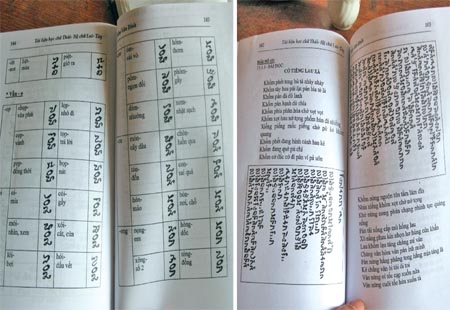Application of Thai ethnic writing processing technology
The application of information processing and writing technology of Thai people in Vietnam is a new, leading solution and is currently the only one in the country in the field of application of written word processing technology.

Thai script (Artwork)
Works by bachelor Phan Anh Dung, Dr. Ngo Trung Viet and colleagues of the Institute of Information Technology, aiming to preserve the culture-writing of Thai people and the future can be Cham and Khmer as well as Nom (Viet, Tay-Nung) .
Software system and website support Vietnamese Thai script has high completeness, including 4 components: Thai Unicode font set, Thai typewriter on Windows and on Linux, Thai web page, online dictionary Thai word line.
In order to meet the needs of learning and teaching Thai characters for ethnic minority students as well as the study of Thai studies, in addition to creating fonts and percussion for Thai words, there is a Web page initially introduced. Thai word, put up the ancient Thai culture texts, download Thai software and fonts to serve the need to learn and look up Thai letters http://www.huesoft.com.vn/chuthaivietnam .
The online Thai dictionary page is quite simple, but it has acquired advanced technologies such as using Hibernate, Ajax to speed up access, allowing guessing at the moment of typing. Currently the Thai Dictionary Dictionary is temporarily located at http://sager-pc.cs.edu/~huesoft/thaiviet .
Mr. Phan Anh Dung said that this is a project of great significance in the field of culture and society. Thai people in Vietnam are the third most populous after the Kinh and Tay, the early ethnic minorities have their own writing, from the 11th century.
Currently, the project has gained the trust of the Thai people in Vietnam, because not only did it purely do technical processing work, but the group invested in researching, deeply understanding the culture, writing, grammar, spelling . Thai. At the same time, the authors built a cooperative relationship with Thai research groups such as Lo Mai Cuong and Ca Van Chung groups in Son La, Sam Van Binh groups in Nghe An.
- Why are Thai chicken prices
- Japan transferred rice processing technology to Vietnam
- Application of biotechnology in the processing industry
- Decipher the life of the most mysterious nation in Vietnam
- Hand writing helps remember better
- Why Thai Binh princess does not succeed Vo Tac Thien?
- Application of modern technology in Kone elevator
- Air pen
- China introduced robots capable of writing newspapers
- How can the Thai team survive in the cave?
- New way to decode ancient writing
- Robot will write a novel
 'Barefoot engineer' invents a pipeless pump
'Barefoot engineer' invents a pipeless pump Process of handling dead pigs due to disease
Process of handling dead pigs due to disease Radiometer
Radiometer Warp Engine: Technology brings us closer to the speed of light
Warp Engine: Technology brings us closer to the speed of light